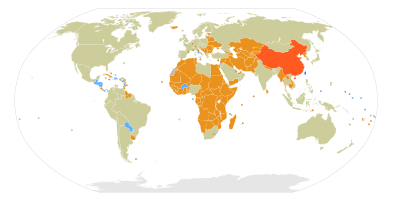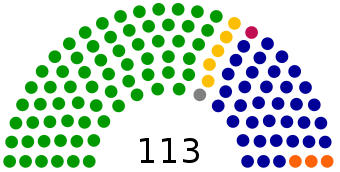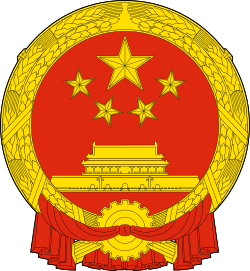Two Chinas
| Two Chinas | |||||||||||||
|
Territory controlled by the People's Republic of China (PRC) (purple) and the Republic of China (ROC) (orange). The size of minor islands has been exaggerated in this map for ease of identification. | |||||||||||||
| Traditional Chinese | 兩個中國 | ||||||||||||
|---|---|---|---|---|---|---|---|---|---|---|---|---|---|
| Simplified Chinese | 两个中国 | ||||||||||||
| |||||||||||||
The term Two Chinas refers to the current situation where two political entities each name themselves "China":[1]
-
 People's Republic of China (PRC), commonly known as "China", established in 1949, controlling mainland China and two special administrative regions, Hong Kong and Macau.
People's Republic of China (PRC), commonly known as "China", established in 1949, controlling mainland China and two special administrative regions, Hong Kong and Macau. -
 Republic of China (ROC) which controlled mainland China from its establishment in 1911/1912 to 1949. Since the end of 1949 when it lost control of mainland China in the Chinese Civil War, the ROC controls only Taiwan and some nearby island groups, and is now commonly known as "Taiwan".
Republic of China (ROC) which controlled mainland China from its establishment in 1911/1912 to 1949. Since the end of 1949 when it lost control of mainland China in the Chinese Civil War, the ROC controls only Taiwan and some nearby island groups, and is now commonly known as "Taiwan".
Background
In 1912, the Xuantong Emperor abdicated as a result of the Xinhai Revolution, and the Republic of China was established in Nanjing by revolutionaries under Sun Yat-sen. At the same time, the Beiyang Government, led by Yuan Shikai, a former Qing Dynasty General, existed in Beijing, whose legitimacy was challenged by the Nanjing government under the Kuomintang, or the Chinese Nationalist Party.
From 1912 to 1949, China was scarred by Warlords, the Japanese invasion and the Chinese Civil War. Throughout this turbulent period, various short lived governments have existed in China. This includes Yuan Shikai's Beiyang Government (1912-1928), the Chinese Soviet Republic established by the Communist Party of China (1931-1937),[2] the Fujian People's Government (1933-1934), the puppet state of Manchukuo (1932-1945), and Wang Jingwei's Japanese sponsored puppet state (1940-1945).
As the Chinese Civil War ended in 1949, the Chinese communist People's Republic of China (PRC), led by Chairman Mao Zedong, took control of Mainland China. The Republic of China, led by President Chiang Kai-Shek, retreated the government of the Republic of China to Taiwan.
Though fighting continued for the next several years, by the time of the Korean War the lines of control were sharply drawn: the Communist-led People's Republic of China government in Beijing controlled most of mainland China, while the Kuomintang-led Republic of China government, now in Taipei, controlled the island of Taiwan, some surrounding islands, and a number of islands off the coast of Fujian. This stale-mate was enforced with the assistance of the United States government which began deterring an invasion of Taiwan after the start of the Korean War.
For many years, both governments contended to be the sole legitimate government of China. With the fighting largely over, the major battleground became diplomatic. Before the 1970s, the Republic of China was still recognized by many countries and the United Nations as the sole legitimate government of "China", which included both mainland China and Taiwan. The Republic of China had been a founding member of the United Nations and was one of the five permanent members of the Security Council until 1971, when they were expelled from the UN and China's representation was replaced by the People's Republic of China (PRC) via UN General Assembly Resolution 2758. Before the 1970s, few foreign governments recognised the People's Republic of China. The first governments to recognise it as the government of People's Republic of China were Soviet bloc countries, members of the non-aligned movement, and the United Kingdom (1950). The catalyst to change came in 1971, when the United Nations General Assembly expelled representatives of Chiang Kai-shek by refusing to recognise their accreditations as representatives of China. Recognition for the People's Republic of China soon followed from most other governments, including the United States. The Republic of China continued to compete with the People's Republic of China (PRC) to be recognised as the legitimate government of China.
Since the 1990s, however, a rising movement for formal recognition of Taiwanese independence has made the political status of Taiwan the dominant issue, replacing the debate about the legitimate government of China. A view in Taiwan is that the Republic of China and the People's Republic of China are both sovereign, thus forming "two Chinas", or "one China, one Taiwan". Former Republic of China President Chen Shui-bian adamantly supported this status quo, and accordingly largely abandoned the campaign for the Republic of China to be recognised as the sole legitimate government of China. Under President Chen, the ROC government was campaigning for the Republic of China to join the United Nations as representative of its effective territory—Taiwan and nearby islands—only. The next Taiwanese President Ma Ying-Jeou ceased that push.
Current situation

The People's Republic of China (which administers mainland China) and Republic of China (which administers Taiwan) do not officially recognize each other's sovereignty. The official position of the governments of both the People's Republic of China and Republic of China remain that there is only one sovereign entity of China, and that each of them represents the legitimate government of all of China - including both mainland China and Taiwan - and the other is illegitimate. However, in recent years, the rhetorics of the two governments have diverged significantly on the issue of "Two Chinas" or "One China, one Taiwan".
People's Republic of China
The government of the People's Republic of China (PRC) opposes treating the Republic of China (Taiwan) as an independent country and portrays Taiwan as a province of the PRC.[3] The People's Republic of China government has consistently opposed "two Chinas", instead espousing that all of "China" is under one single, indivisible sovereignty under its "One China Principle", explicitly including Taiwan. Under this principle, while the PRC has no de facto control over territory administered by the ROC (Taiwan), the PRC nevertheless claims that the territories controlled by both the PRC and ROC (Taiwan) are part of the same, indivisible sovereign entity "China".[4][5] Furthermore, under the succession of states theory, the PRC claims that it has succeeded the ROC as the government of "China", and thus the current ROC regime based in Taiwan is illegitimate and has been superseded.
PRC government policy mandates that any country that wishes to establish diplomatic relationship with the PRC must first discontinue any formal relationship with the ROC. According to The Fletcher Forum of World Affairs, "non-recognition of the Taiwanese government is a prerequisite for conducting formal diplomatic relations with the PRC —in effect forcing other governments to choose between Beijing and Taipei."[6][7] In order to compete for other countries' recognition, each government has given money to a certain few small countries. Both the PRC and ROC governments have accused each other of monetary diplomacy. Several small African and Caribbean countries have established and discontinued diplomatic relationships with both sides several times in exchange for huge financial support from each side.[8] The PRC also uses its international influence to prohibit the ROC from entering international events such as the Olympic Games under its official name. Instead, the ROC was forced to adopt the name Chinese Taipei to enter such events since the 1980s.[9] Furthermore, on press releases and other media, the PRC never refers to the ROC as such, instead referring to the territory of Taiwan as "China's Taiwan Province", and to the ROC government as "the Taiwan authority."
Republic of China
Until the constitutional reforms of 1991 the Republic of China officially claimed sovereignty over mainland China. ROC authorities clarified the constitutional reforms by stating they do not "dispute the fact that the P.R.C. controls mainland China."[10]
The emergence of free speech and democracy in Taiwan and the resulting ability of the Taiwan independence movement to gain ground has further complicated matters. While the PRC finds the "Two Chinas" unpalatable, it considers a non-Chinese Taiwan independence created Republic of Taiwan an even worse alternative. Handling of the issue has varied by administration now that the democratic Republic of China (Taiwan) has experienced several changes of leadership of the Executive Yuan.
In 1999, then President Lee Teng-hui defined the relationship as "Special state-to-state relations".
President Chen Shui-bian (2000–2008) declared in 2002 that "with Taiwan and China on each side of the Taiwan Strait, each side is a country". In 2003 he explained that "Taiwan is not a province of one country nor is it a state of another".[11][12] The Chen administration took steps to use Taiwan internationally in the name of preventing confusion over the "two Chinas". For example, some Taiwanese have had difficulty traveling with "Republic of China" passports as officials mistook them for citizens of the People's Republic of China, so "Taiwan" has been added to the Republic of China passports.[13]
In September 2008 President Ma Ying-jeou stated that the relations are neither between two Chinas nor two states, saying instead that it is a "special relationship". Further, he stated that the sovereignty issues between the two cannot be resolved at present, but he quoted the '1992 Consensus', currently accepted by both sides, as a temporary measure until a solution becomes available.[14] The spokesman for the ROC Presidential Office Wang Yu-chi (Chinese: 王郁琦) later clarified the President's statement and said that the relations are between two regions of one country, based on the ROC Constitutional position, the Statute Governing the Relations Between the Peoples of the Taiwan Area and Mainland Area and the '1992 Consensus'.[15]
Historical uses
In Chinese history, it was rare for one dynasty to end calmly and transition smoothly to a new one. Dynasties were often established before the overthrow of an existing regime, or continued for a time after they had been defeated.
As a result, there have been many periods when different regimes claimed to speak for all of China. For example, the southern Song Dynasty, the Jurchen Jin Dynasty, the Khitan Liao Dynasty, and the Tangut Western Xia all existed contemporaneously; likewise, the Manchu Qing China co-existed with Ming China from 1636 to 1644, while remnants of the Ming (known to historians as Southern Ming) continued governance in certain areas until 1683, when Ming forces on Taiwan surrendered to the Qing.
See also
- Chinese reunification
- One-China policy
- Political status of Taiwan
- Desinicization
- Legal status of Taiwan
- Exclusive Mandate
- Taiwan independence
- Chinese Soviet Republic
References
- ↑ http://www.heritage.org/research/asiaandthepacific/bg19.cfm
- ↑ Lyman P. Van Slyke, The Chinese Communist movement: a report of the United States War Department, July 1945, Stanford University Press, 1968, p. 44
- ↑ "CONSTITUTION OF THE PEOPLE'S REPUBLIC OF CHINA". The People's Daily — Read 3rd paragraph, 10th line-. 1982-12-04.
- ↑ "CONSTITUTION OF THE PEOPLE'S REPUBLIC OF CHINA". The People's Daily — Read 3rd paragraph, 10th line-. 1982-12-04.
- ↑ "Anti-Secession Law". The People's Daily. 2005-03-14.
- ↑ Erikson, Daniel P.; Chen, Janice (2007). "China, Taiwan, and the Battle for Latin America". The Fletcher Forum of World Affairs (31, number 2): 71.
- ↑ "The One-China Principle and the Taiwan Issue". China Internet Information Center. Retrieved 2014-04-09.
- ↑ "China and Taiwan in Africa". HiiDunia. Retrieved 2014-04-09.
- ↑ Catherine K. Lin (2008-08-05). "How 'Chinese Taipei' came about". Taipei Times.
- ↑ "TAIWAN (REPUBLIC OF CHINA): Constitution, Government & Legislation". Jurist Legal intelligence, Pitt University. Retrieved 30 July 2011.
- ↑ "Extracted text of the telecast relating to cross-strait relations" (in Chinese). Mainland Affairs Council of Republic of China. 2002-08-03.
台灣不是別人的一部分;不是別人的地方政府、別人的一省
- ↑ Wang, James (2003-10-22). "Fortune will favor a brave Taiwan". Taipei Times.
- ↑ Taipei Times - archives
- ↑ "Taiwan and China in 'special relations': Ma". China Post. 2008-09-04.
- ↑ "Presidential Office defends Ma". Taipei Times. 2008-09-05.





